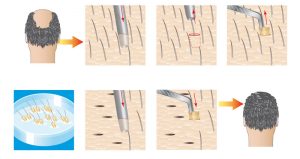Hair-Loss Treatment: Rogaine to the Rescue?
Despite the outlandish number of “therapies” available for hair-loss treatment, only Rogaine is proven thus far to produce the hairy result you want.
Looking for a hair-loss treatment? Your most reliable and least-expensive first step is a consultation with a dermatologist. A mind-blowing number of thinning hair and hair-loss remedies are available, but the supporting research tends to not be peer-reviewed or duplicated by an uninvolved third party—two important criteria for judging research as legitimate.
“Dermatologists know that hair loss could be an important clue that something else is going on inside the body, such as a hormonal abnormality, lupus, or thyroid disease,” according to Mary Gail Mercurio, MD, FAAD, Associate Professor of Dermatology and Program Director of Dermatology Residency at the University of Rochester in Rochester, N.Y. “That’s why I can’t stress enough the importance of getting an accurate, and early, diagnosis for hair loss.”
Once you have a diagnosis, you can determine what hair-loss treatment is right for you.
FDA-Approved Hair-Loss Treatments
COMMON-SENSE HAIR-LOSS PREVENTION
- Avoid tight hair styles that pull your hair.
- Be sure your comb or brush is gentle, without rounded tips.
- Dry your hair gently, without using a too hot blow dryer. Avoid rubbing your hair dry.
- Eat a properly balanced diet, rich in nutrients like vitamin A and iron to support hair growth.
- Minimize washing your hair.
- Use a volumizing shampoo and lightweight conditioner.
- Wear a hat: Avoid sun exposure.
Who among us hasn’t heard of Rogaine (minoxidil), a prescription drug you rub into the scalp for hair-loss treatment? Minoxidil 2% is the only topical medication FDA-approved for female-pattern hair loss, and minoxidil 5% foam is FDA-approved for male-pattern hair loss.
“Minoxidil may stimulate hair growth on top of the scalp and stop hair from getting thinner,” says Shari Lipner, MD, PhD, a dermatologist at Weill Cornell Medicine. “It may take six months to a year to see results, but it’s available over the counter, and it is effective in stopping hair loss or stimulating hair growth in more than half of patients who use it properly.”
Speaking at the 68th Annual Meeting of the American Academy of Dermatology (Academy), Dr. Mercurio pointed out that minoxidil 5% has been shown to be very effective in women as well but encourages women to consult a dermatologist before starting the treatment because it can sometimes increase facial hair growth in women.
While minoxidil does not grow new hair, it works by prolonging the growth phase of hair, which provides more time for hair to grow out to its full density. Dr. Mercurio stresses that women must be patient with this treatment, as noticeable results usually take three to four months and the product must be used twice a day.
Doctors can also prescribe men a low dose of Propecia (finasteride) for hair-loss treatment. It’s a tablet you swallow. The drug will only work at increasing hair growth for as long as you’re taking it, but one of the side effects is impotence, making it a less popular choice.
Surgical Treatments for Hair Loss
The only surgical option for hair-loss treatment is a hair transplant. This is done by taking hair grafts from the areas of good hair growth on your own scalp and transplanting them to the areas without hair. It is a costly procedure, but it can usually be done in the doctor’s office.

A surgical option in the hair loss treatment area involves the transplant of healthy hair follicles from one part of the scalp to a another. (Illustration: © Alexonline | Dreamstime.com)
“Most people can return to work several days after surgery,” reports Healthline.com. “It’s normal for the transplanted hair to fall out two to three weeks after the procedure. This makes way for new hair growth. Most people will see about 60 percent new hair growth six to nine months after surgery.” Follow-up treatment is usually Rogaine.
Underway: New Hair Loss Treatments
Developments in hair loss treatment include the following.
HAIR VITAMINS, HAIR LOSS, AND GRAY HAIR
The best way to ensure adequate intake of hair vitamins is a healthy, balanced diet. Nutrients for your hair function best from the inside out. To find out more, please visit author Cindy Foley‘s post “The Search for Healthy Hair Vitamins.”
For information on hair loss and gray hair, see these posts:
- Hair follicle “aggregates”: One treatment option on the way is coming from researchers at Yokohama National University. They have developed a method for the mass preparation of cellular aggregates, also known as “hair follicle germs (HFGs).” The research group transferred prepared HFGs from a fabricated approximately 300-microwell array, called “HFG chip,” to generate hair follicles and hairs on a mouse body. The group confirmed black hair generation at both the back and scalp transplantation sites. The regenerated hair exhibited the typical hair cycle of murine (rodent) hair.”This simple method is very robust and promising,” says Junji Fukuda, professor at Yokohama. “In fact, we have preliminary data that suggests human HFG formation using human keratinocytes and dermal papilla cells.”
- Laser treatments for hair loss: In 2013, the FDA approved the Theradome helmet for stimulating hair growth using tiny lasers that increase circulation to hair follicles and improve cellular metabolism on the scalp. Other laser brushes, combs, and devices are also available. The problem is that the research supporting (or disputing) their value is lacking. Laser hair removal techniques, however, are one of the most popular and reliable ways to rid yourself of unwanted hair.
- Stem-cell activation: With the amazing advances in stem-cell research, it’s no surprise that researchers at UCLA recently discovered they can activate the stem cells in the hair follicle to make hair grow. The research was published in the journal Nature Cell Biology. Hair-follicle stem cells are a natural hair-loss treatment: These long-lived cells in the hair follicle are in the skin and produce hair throughout a person’s lifetime. They’re usually inactive, except during a new hair cycle, when hair growth occurs. If they don’t activate, hair loss occurs.The team identified two drugs that, when applied to the skin of mice, influenced hair-follicle stem cells in distinct ways to promote lactate production, which would accelerate hair follicle cell activation and increase the hair cycle.
The first drug, called RCGD423, activates a cellular-signaling pathway called JAK-Stat, which transmits information from outside the cell to the nucleus of the cell. The research showed that JAK-Stat activation leads to the increased production of lactate and this in turn drives hair follicle stem cell activation and quicker hair growth. The other drug, called UK5099, blocks pyruvate from entering the mitochondria, which forces the production of lactate in the hair follicle stem cells and accelerates hair growth in mice.
“Through this study, we gained a lot of interesting insight into new ways to activate stem cells,” said Aimee Flores, a predoctoral trainee in Lowry’s lab and first author of the study. “The idea of using drugs to stimulate hair growth through hair follicle stem cells is very promising…. I think we’ve only just begun to understand the critical role metabolism plays in hair growth and stem cells in general.”


 MGH Study: Hot Yoga May Help Ease Depression Symptoms, but Be Mindful of Health Concerns
MGH Study: Hot Yoga May Help Ease Depression Symptoms, but Be Mindful of Health Concerns  Ramsay Hunt Syndrome
Ramsay Hunt Syndrome 
Hair loss treatments range from application of Rogaine to hair follicle transplants to new developments currently being researched.
© Agenturfotografin | Dreamstime.com